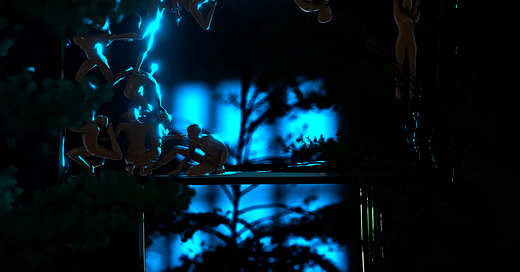Aria Leth Schütze aka Alto Aria are known as a composer, experimental artist, and co-founder of Rhizome – a Copenhagen-based experimental label with an adventurous and community-centered approach to curation. In the four years since its inception, the label has put out a string of offbeat releases ranging from left-field variations on alt-rock and dream pop to loungey club experiments and more ambient-oriented works that we've come to associate with Scandinavian sound. While Rhizome's catalog brings a breath of fresh air to the scene, its strongest point is its focus on building bridges, moving forward, and shape-shifting within a wider community. This understanding of interdependence is reflected in Alto Aria's collaborations with label-mate Mads Krue Bugge aka Skarv and Croatian Amor, as well as in their solo work.
From their first album, Tides, Alto Aria have explored the transient acts of writing and rewriting oneself through collisions with the outside world – natural elements, friendships, and the humanizing touch of another person. On their latest album Limerence, they devise an anatomy of heartbreak, gently guiding the listener through all the dissonant, confusing stages of limerence one is left with after a breakup. Limerence is a joint project, and Alto Aria's most collaborative one to date. Artists and friends such as Viola Faber, Laura Cecilie, Holger Seidelin, and Frederik Lehmann were invited to infuse the record with their histories of heartbreak, resulting in the album's most standout pieces.
Sonically, the album ebbs and flows between classical elements, acoustic indie, and strategically placed soul-crushing beats. The formula may sound familiar, but each track reveals an unpredictable rhythmic structure, a field recording shrouded in a hazy wall of sound or a disruptive burst of industrial clangs. Throughout its thirteen tracks, Limerence induces a gleeful anticipation of what's to come that coexists seamlessly with a second-hand yearning experienced through its narrative. Alto Aria's barely-there yet ever-present vocals, ranging from delicate alt-pop sensibility to fractured wails reminiscent of Beth Gibbons, serve as a guiding thread that navigates the listener through the album's many emotional turmoils.
From the opening chords of the album's first track “Leave the Door Open”, Alto Aria establishes a cozy, almost butterfly-inducing sense of grief that will dominate the rest of the release. Pain is inviting in its vulnerability – instead of closing in on itself, it extends a hand and asks to be known. On “Bend Towards the Light”, the mournful strings give way to murky sounds of rain and sacral hum backed by a kick drum. This atmosphere evolves through “Dreaming About You” and “Where the Heart Is,” where rich, solemn sounds of violin accompany a lament on the mixed feelings of a final encounter – that all-consuming need for closeness only intensified by the imminent departure.
The experience is accurately portrayed in the intricate video for the single “Thought There Would Be More,” by visual artist and animator Signe Dige. In the video, visions of distorted trees and vacant spaces are juxtaposed with peaceful scenes of living doll-like figures standing in the water, formless and fluid, then leaning on each other against a warm light. The eerie aesthetic reminiscent of dystopian video games complements the interplay of bright melodies and abrasive interruptions.
From there, the album picks up the pace with a series of collaborative tracks. “So Much But Not Enough,” featuring Viola Faber, opens with a field recording of a crowd that soon melts into expansive synths and staggering irregular beats. Alto Aria repeats a single phrase: “I have so much to give/ I have so much love” that speaks volumes in its simplicity, describing a cloying notion of love that has nowhere to go so it lives in the body like an estranged object, a fairytale not yet dispelled. “Angels in the Valley,” a collaboration with Laura Cecilie, deals with a faint but lively glimmer of hope for reconciliation before settling back into the crystalline sadness of “Fall Is My Favorite,” vaguely reminiscent of the “Sugar For The Pill”-era Slowdive.
The tracks featuring Holger Seidelin and Frederik Lehmann are more hybrid and present the biggest stylistic and emotional detours: In “Went Here to Forget“, the grief can be purged on the dance floor, with Seidelin's sensual vocals and propulsive beats shrouded in maximalist pop. The darker, more anxious atmosphere of „Blowing Kisses to the Wind“ evolves through jittery tectonic beats and thumps elevated by Alto Aria's disturbingly angelic vocals.
After some welcome genre-hopping, “Did You Get My Message” and “To Keep My Own Dream” restore the rich, mournful ambiance, while “Like You've Never Been Hurt” provides a fitting closer, its blissful piano counterbalancing Alto Aria's fading wails and receding footsteps that signal the final departure, the end.
Heartbreak is a visceral, often solitary experience. On Limerence, Alto Aria turn their attention to the transformative potential of grief – how we can purge and heal by allowing our pain to be witnessed and shared. They approach the endeavor of turning heartbreak into an art form with nuance and curiosity, resulting in an album that glides elegantly between introspection and communal alchemy, with just enough melodrama to capture the life-affirming impact of unrequited love.






